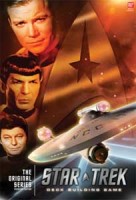
Star Trek Deck Building Game: The Original Series
Overview
The Star Trek Original Series DBG allows players to command your own Constitution class starship, recruit James Kirk, Spock, Scottie and Bones and a host of other characters from the original series and set off across the unexplored galaxy to accomplish missions! Be the first to 300 Victory points to win! Unique exploration, missions and hand management options, with a healthy dose of interstellar infection as well. Shuffle, Draw, Energize!
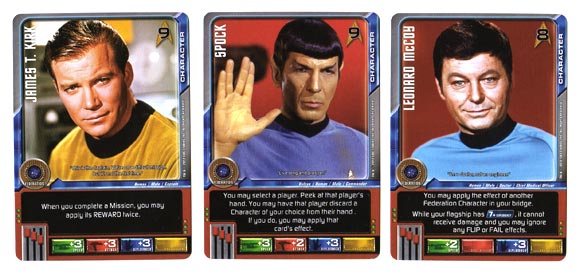
Set Up
Each Player begins with starting deck of 10 cards and takes one of the Starter Starship cards and places it in front of them. Their starter deck is shuffled and placed down ready to play.
The Starbase Deck and Space Deck areas are where all the cards that players will recruit and encounter are laid out. The Starbase Deck includes 50 unique characters form the original Star Trek series, as well as 25 assorted Setup, Maneuver and Special cards that may be purchased during the game. All of these are shuffled together to form the Starbase Deck. This game includes two 25-card scenarios deck that can be mixed into the Starbase Deck: a standard Exploration Scenario and an Infection Scenario.
Next, the 40-card Space Deck is now constructed using 15 standard Mission cards, and an additional 25 cards that vary depending upon the Scenario being played. (Standard Exploration or Infection as above). The deck is shuffled and placed to one side. Finally, nine cards are dealt into a 3 x 3 grid to form the Starbase Search Area. These are the cards players can buy and add to their hands during the game.
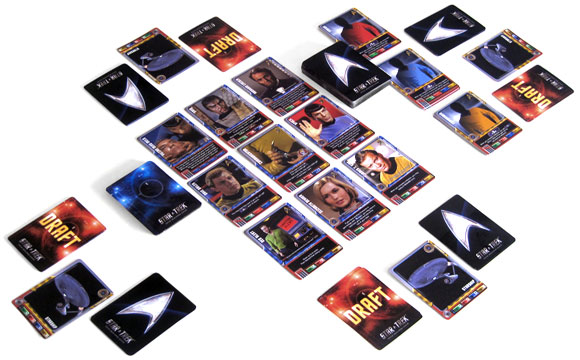
Lastly, there are 15 standard mission “draft cards” are included in this version of the game. Three are dealt to each player and the rest are set aside. Each player chooses only two of these and keeping them hidden places them in front of them. The rest of the Draft cards are not used.
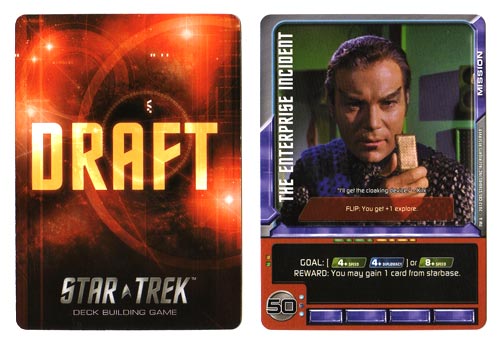
Gameplay
A player’s turn consists of an Action Phase and/or a Trash Phase. Players may use the Trash Phase if they cannot perform any other Actions, and can trash one card from her hand and end their turn. Otherwise all the cool stuff happens in the Action Phase. If a player doesn’t trash a card they can take any or all of the following actions in any order and as many times as they wish.
- Play a Card: Players may take one card from their hand and play it to their “Bridge.” These might be a Character that will add vital stats to that player’s Flagship. A Maneuver Card, which will not only provide stats to your Flagship but a game effect as well, or a Setup that will have an immediate game effect and will be discarded. The Stats are the foundation of completing Missions and gaining Victory points. The Four stats are: Speed, Attack, Diplomacy and Shields. (See “Explore” below to see how these are used.)
- Buy a Card: You may play cards that have Experience Points on them (XP) and purchase a card from the Starbase equal to or less than that total. A player may buy any number of cards as long as they have the XP to pay for all of them. The purchased card is taken from the Starbase, and added to a player’s discard pile.
- Search: A player may choose and discard one card from the Starbase and then draw another from the Starbase deck to replace it. This keeps valuable card out of your opponents’ hands, gets rid of duplicates and allows a player to try to gain access to that critical card which will have the stats needed to complete missions.
- Explore: Flip the top card of the Space Deck and face whatever mission or event awaits! Each Mission and some events have a Goal: In order to complete a Mission a player will have to gather the necessary stats from all the cards on their Bridge to meet the requirements of the Goal. Once accomplished, Missions grant a Reward – often the Victory points necessary to win! Events may also have a specific Goal but may also cause player to take part in a Battle Simulation (explained below).
- Repair: Players may spend XP to repair their ship on a one-for-one basis.
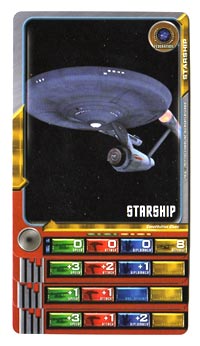
Gameplay continues in this way as players build their decks, play cards to their bridge and attempt Missions and face events from the Space Deck in an attempt to reach 300 VP. Players also have the goal of completing their two “Draft” Missions that they chose at the beginning of the game. These are kept secret from other players until revealed. Each is worth 50 Victory Points toward that players victory point total.
Many other game play possibilities are possible based solely upon the unique cards included in each of the two scenarios provided. But overall, players must manage and utilize their resources, complete missions to gain the most VPs, and keep their opponent’s in check, making sure they don’t gain the card advantage necessary to win.
Components
The box art and graphics are top quality – strong, vibrant images that would make any trekker drool. Taking a different direction with the box inserts, Bandai has opted for cardboard separators instead of the foam dividers included in their Next Gen DBG products. These just don’t work as well, and cards slide about a bit in the box. But it’s a minor grievance. Laid out during play, the game is fetching!
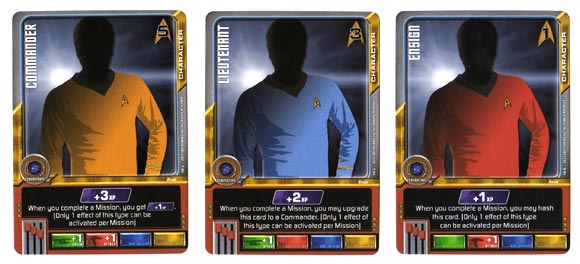
Learning Curve
High. As with all Deck-builders, the basic player turn is quite simple. The true “curve” comes when learning and being able to utilize all the various card effects to one’s advantage. Especially with 50 unique characters in the Starbase, each with a unique effect, it can take some plays to really grasp the deeper game play strategies.
Who would enjoy this game?
Final Thoughts
At first glance, the Star Trek Original Series Deck Building Game may only attract a Trekker, or those familiar with the Next Gen version of the game. With such a huge amount of board and card games in the market – especially deck-builders – most may just dismiss this as a licensed product not worth the time or effort. It even seems some of the major reviewers have passed this and the previous Trek DBG releases over. With several new rule adjustments, this stand-alone expansion is worth the time and money. Here’s why:
Player interaction in the game is noticeable and there are many effects that allow players to affect other player’s hands, decks and missions – increasing the competitive feeling of the game.
Often times starter cards are underpowered and difficult to cycle out of the deck. The Ensign, Lieutenant and Commander cards now have effects on them that allow them to be trashed or upgraded for cards in the Starbase when a Mission completes. This creates a much faster game progression and very few, if any, “dead hands.” In fact, the entire game zips along at Warp speed more so than other deck-builders and the previous Star Trek DBG releases. More intense, better play time means a positive game experience.
Experience points to purchase cards are more prevalent. New game effects and card combinations (especially when choosing draft missions) can create a much faster XP build – if you have the ability to play the combos. This really promotes good deck construction and a less random feel to the game. A higher level of deck construction strategy is really what sets a deck-builder apart.
Each player also begins with 2 almost random draft missions, that, hidden from the other players, gives the game an immediate focus and strategy for each player. Comprising a third if the 300 VP needed to win, the draft missions are a legitimate focus during game play, but don’t detract from the “exploration” feel that is critical to a Star Trek themed game.
It appears that Alex Bykov and the Bandai team have made a solid game even better, and this version of the Star Trek DBG is an excellent one. The exploration mechanics provide a great sense of anticipation of encountering the unknown, and from a purely mechanical standpoint, the game matrix is very tight and interactive. Bandai also says that all three versions can be intermixed providing many more card and mission combinations. Kirk and Picard together exploring space? Well they met in Star Trek Generations right? This brings up one final point.
From a Trek purist’s standpoint, when would you possibly have a Romulan Commander, Sarek, Bones and the legendary Klingon: Kahless on a Constitution class Starship at the same time completing missions or engaging in Battle Simulations. It all seems a bit of a mish-mash for the sake of including well-known characters in a deck-building format. In this version there are even the evil Terran versions of Spock, Sulu and others, that create a true time paradox if you can buy a Terran (bearded) Spock and the normal green blooded Vulcan we all know and love and have them exist on your bridge at that same time. Silly right?
Exactly. Star Trek, has allowed much more of a time and quantum universe crossover than many other sci-fi and fantasy intellectual properties. We as fans must quantify our relationship to the stories by basing the universe in some sort of reality. Well, that’s what we do. It has to make sense for us to grab on and hold tight (and explain it to those who may not “get it.”)
And so, if you as a Star Trek purist and gamer need to have the Trek universe line up perfectly in your games; to make the stories happen in a linear fashion and recreate the Star Trek TV or movie experience, then the Star Trek DBG is NOT the game for you. But if you are a Star Trek fan, enjoy a very tight and challenging deck-builder with great player interaction, a fast start a quick game build-up to the mid game and a balanced end game experience where no one player will run away with the game, then this game will more than satisfy. In the spirit of Star Trek and Gene Roddenberry’s original vision: explore and enjoy!
User Reviews (0)
Add a Review for "Star Trek Deck Building Game: The Original Series"
You must be logged in to add a review.

Be the First to Add a Review!